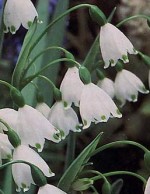 In spite of its name, summer snowflake appears in early spring with the daffodils. They do well under deciduous trees where they can get sun in late winter and spring but tolerate moist spots and do well near ponds and streams. The pendant, bell-shaped milky-white flowers consist of three petals and three sepals are tipped with green and all look alike. Three to five fragrant flowers hang from each slender flower stalk that rises above 4-6 strappy dark green 1-2’ long leaves that form a graceful vase-shaped clump. Best planted in large drifts, summer snowflakes will naturalize easily and, in fact, are often seen in old cemeteries and abandoned home sites. Rodents avoid them. If you want to grow snowflakes in the South this species is the one to grow as spring snowflakes do not do well in heat and are best left to Northern gardeners.
In spite of its name, summer snowflake appears in early spring with the daffodils. They do well under deciduous trees where they can get sun in late winter and spring but tolerate moist spots and do well near ponds and streams. The pendant, bell-shaped milky-white flowers consist of three petals and three sepals are tipped with green and all look alike. Three to five fragrant flowers hang from each slender flower stalk that rises above 4-6 strappy dark green 1-2’ long leaves that form a graceful vase-shaped clump. Best planted in large drifts, summer snowflakes will naturalize easily and, in fact, are often seen in old cemeteries and abandoned home sites. Rodents avoid them. If you want to grow snowflakes in the South this species is the one to grow as spring snowflakes do not do well in heat and are best left to Northern gardeners.
Type: Bulb.
Bloom: Three to five mildly fragrant flowers 1” wide hang from slender scapes; each flower is bell-shaped and consists of three white sepals and three white petals all of which are tipped with green and appear similar. Blooms in early spring in most of its range, in the fall and winter in zone 9.
Foliage: Grass like leaves, 1-2‘ long and 1” wide bend downward to form vase-shaped clump.
Size: 12-20” H x 12″ W.
Light: Sun to light shade.
Soil: Average, moist, well drained soil; tolerates drought in summer.
Hardiness: USDA zones 4-9.
Care: Plant in fall 6” deep and 6” apart; allow foliage to mature after blooming.
Pests and Diseases: None of importance.
Propagation: Divisions.
Companion plants: Daffodils, grape hyacinths; under deciduous trees and shrubs.
Outstanding Selections: ‘Gravtye Giant’ (more vigorous and with larger and more numerous flowers than the species.)
